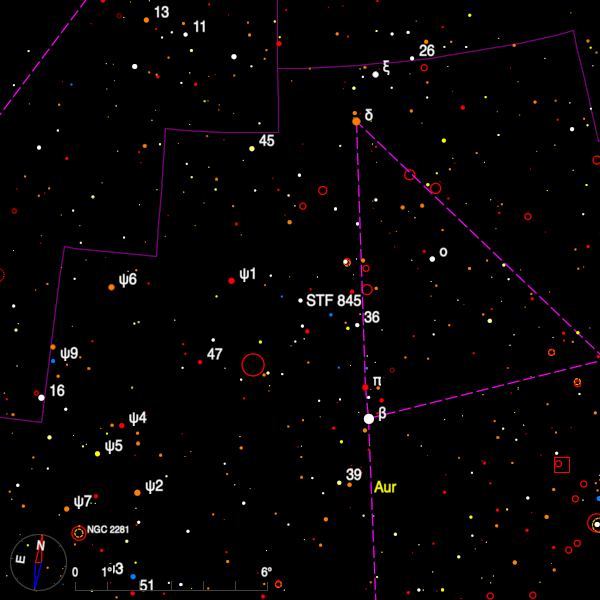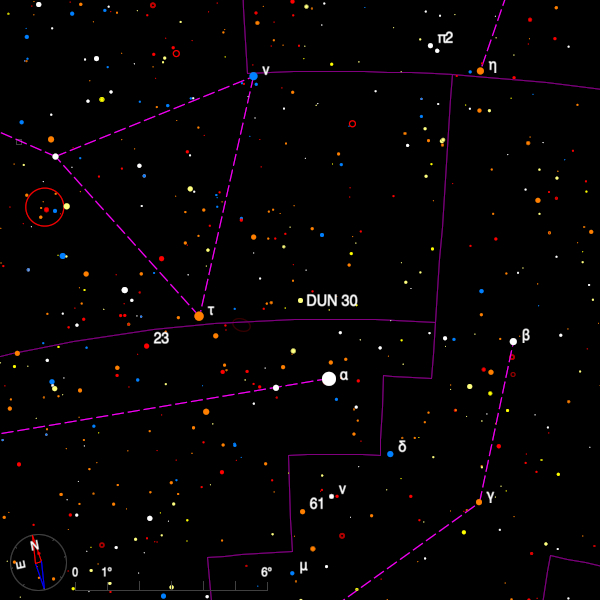Double Star of the Month in Pictor
-
January 2023 - Double Star of the Month
STF 845 lies in Auriga (06 11 36.59 +48 42 39.6) and is also known as 41 Aurigae and it is also H 3 82, observed by William Herschel in November 1782 and recorded by him as
a pretty double star
. It is a beautiful pair for the small telescope. The writer first saw it in 1969 using the 12-inch reflector of a friend. At x208 the colours were noted as yellow and lilac. The Washington Double Star (WDS) catalogue gives the spectral types as A1V and A6V.
A finder chart for the double star STF 845 in Auriga created with Cartes du Ciel. James Dunlop found the 30th entry in his catalogue in 1826. It is located in Pictor at 06 29 40.03 -50 14 20.7 some 2.5 degrees NNE of Canopus. It offers a fine sight to the small telescope user.
The stars are magnitudes 6.0 and 8.0 and at present they are separated by 11".5, being 14" apart when observed by Dunlop. The position angle has hardly changed between these two epochs and is currently 312 degrees.

A finder chart for the double star DUN 30 in Pictor created with Cartes du Ciel. In 1871, Russell, observing with an 11-inch refractor at Sydney Observatory, found the primary star to be a close double. R 65 has a period of 111 years according to Docobo and Ling in 2021. The stars are almost equally bright but according to the orbit, which is extremely eccentric, the separation never exceeds 0".7 and, at times, drops to 0".012 which was the case in mid-2021. By 2027 the stars will be at least 0".4 apart.
In the 1890s Harvard Observatory was site testing in the Peruvian Andes and was using a 13-inch refractor. This telescope discovered several hundred new double stars amongst which was the fainter companion of DUN 30. This has also turned out to be a binary pair of period 101 years, giving a predicted position of 224 degrees, 0".44 in early 2023. The stars have visual magnitudes 8.0 and 8.7.
Bob Argyle - Double Star Section Director
-
Double Star of the Month - December 2009
In this series of short articles, a double star in both the northern and southern hemispheres will be highlighted for observation with small telescopes, with new objects being selected for each month.
80 Tau (4 30 08.60 +15 38 16.2) is a an unequally bright (5.70, 8.12) binary star with a highly inclined orbit in the cluster of bright stars close to Aldebaran, more specifically about half a degree south following the bright binocular pair theta1,2 Tauri. Found by Struve in 1831, the companion headed towards the primary until by 1878, the great Italian observer Dembowski, in one of his last observations, failed to see B in his 7-inch Merz dialyte and by the 1890s the companion was invisible in the largest apertures. The companion passed close to A in the following years and since then has been continuing to widen, reaching maximum separation (1".75) in around 1987. By 2010.0 the star is at 16 degs, 1".64 and should be visible for several decades in 20-cm but choose a good night because the large difference in magnitude makes this a far from easy pair. A itself is a spectroscopic binary and the distance to this system is 150 light years.
Iota Pic (04 50 55.31 -53 27 41.5) is, according to Hartung, "an excellent object for small telescopes" and recorded the colours as yellow. The stars are magnitudes 5.61 and 6.24 and of spectral class F0IV and F4. Each component appears in the Hipparcos catalogue as a separate entry and the parallaxes, whilst each possessed of rather a large error, indicate that the stars are at the same distance from us i.e. about 130 light years and the similar proper motions confirm that this is a true binary system. The WDS catalogue notes that the PA of 59 degs and separation of 12".6 for 2002 is virtually unchanged since the pair was discovered by Dunlop in 1826. The star can be found in western Pictor, about 3 degrees north following alpha Doradus.
Bob Argyle - Double Star Section Director
-
Double Star of the Month - January 2009
In this series of short articles, a double star in both the northern and southern hemispheres will be highlighted for observation with small telescopes, with new objects being selected for each month.
This months column features two stars which are, nominally at least, the 7th brightest in their respective constellations. Theta Aurigae = STT 545 (05 59 43.24 +37 12 46.0) is one of Otto Struve's discoveries at Pulkovo using the 15-inch refractor in 1852 but there are no measures on record until 1871. Orbital motion is slow but retrograde and covers some 60 degrees over the last 130 years. The separation has very slowly increased from 2".1 to the present 3".8. Whilst this may appear to present no problems to the small telescope user, the difference of magnitude certainly does and this system is one of the classic tests for the small aperture. The WDS gives the magnitudes as 2.6 and 7.2 so its not just the brightness difference but the glare from the primary star that has to be dealt with. However, it is the case that small apertures tend to work better on this star than larger ones as the quality of the atmosphere is also an important consideration when observing it. The writer finds it difficult to measure in an 8-inch refractor when the red field illumination of the micrometer is switched on. Theta Aurigae is about 165 light years from the Sun.
Theta Pictoris = DUN 20 (05 24 46.29 -52 18 58.2) was observed by John Herschel in 1835 and noted to be a `fine' pair. It had been discovered by Dunlop in 1826 and whilst Hartung refers to the two components (visual magnitudes 6.24 and 6.74) as pale yellow, the WDS catalogue lists the spectral types as A0V and A2V. In the last 180 years there has been virtually no relative motion between the two stars and the system is ideal for use as a calibrator for filar or eyepiece micrometers (2010.0: 287.6, 38".14). In 1901 Robert Innes found that A was itself a close pair and the system is a difficult one for any but the largest visual telescopes with the current separation not exceeding 0.2 arc seconds until 2010. It then widens to about 0".46 in 2079, the period being 191 years. There are reasons to believe that theta Pic is in fact a quintuple system. One of the stars in the close pair is a spectroscopic binary and the distant companion is also suspected of variable radial velocity. The group is remote with the revised Hipparcos parallax giving the distance as 512 light years with an uncertainty of 25 light years.
Bob Argyle - Double Star Section Director